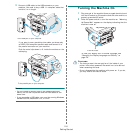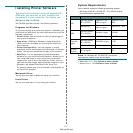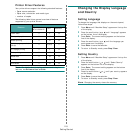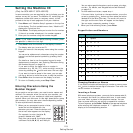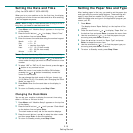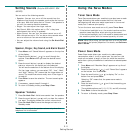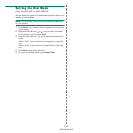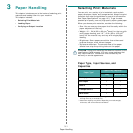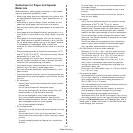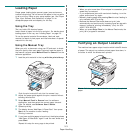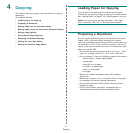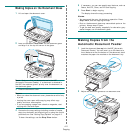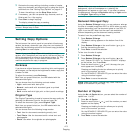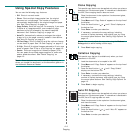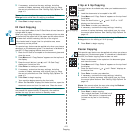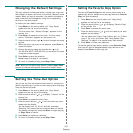
Paper Handling
3.2
Guidelines for Paper and Special
Materials
When selecting or loading paper, envelopes, or other special
material, keep these guidelines in mind:
• Always use paper and other materials that conform with
the specifications listed under “Paper Specifications” on
page 10.3.
• Attempting to print on damp, curled, wrinkled, or torn
paper can cause paper jams and poor print quality.
• Use only high quality copier grade paper for the best print
quality.
• Avoid paper with embossed lettering, perforations, or a
texture that is too smooth or too rough. Paper jams may
occur.
• Store paper in its ream wrapper until you are ready to
use. Place cartons on pallets or shelves, not on the floor.
Do not place heavy objects on top of the paper, whether
it is packaged or unpackaged. Keep it away from
moisture, or other conditions that can cause it to wrinkle
or curl.
• Store unused materials at temperatures between 15
o
C
and 30
o
C (59
o
F to 86
o
F). The relative humidity should
be between 10 % and 70 %.
• During storage, you should use a moisture-proof wrap,
such as a plastic container or bag, to prevent dust and
moisture from contaminating your paper.
• Load special paper types one sheet at a time through the
manual tray or the tray to avoid paper jams.
• Only use materials specifically recommended for use in
laser printers.
• To prevent special materials, such as transparencies and
label sheets from sticking together, remove them as they
print out.
•For envelopes:
Use only well-constructed envelopes with sharp and well
creased folds.
Do not use envelopes with clasps and snaps.
Do not use envelopes with windows, coated lining, self-
adhesive seals, or other synthetic materials.
Do not use damaged or poorly made envelopes.
Only use envelopes recommended for laser printers.
Before loading envelopes in the tray, make sure that they
are undamaged and are not stuck together.
Do not feed stamped envelopes.
• For transparencies:
Place them on a flat surface after removing them from the
machine.
Do not leave them in the tray for long periods of time.
Dust and dirt may accumulate on them, resulting in spotty
printing.
To avoid smudging caused by fingerprints, handle them
carefully.
To avoid fading, do not expose printed transparencies to
prolonged sunlight.
Only use transparencies recommended for use in laser
printers.
Ensure that transparencies are not wrinkled, curled, or
have any torn edges.
• For labels:
Verify that their adhesive material can tolerate a fusing
temperature of 200
o
C (392
o
F) for 0.1 second.
Make sure that there is no exposed adhesive material
between them. Exposed areas can cause labels to peel off
during printing, which can cause paper jams. Exposed
adhesive can also cause damage to machine components.
Do not load a sheet of them through the machine more
than once. The adhesive backing is designed for one pass
through the machine.
Do not use labels that are separating from the backing
sheet or are wrinkled, bubbled or otherwise damaged.
Only use labels recommended for laser printers.
• For Card Stock or Custom-sized materials:
Postcards, 3.5 x 5.8 in. (89 x 148 mm) cards and other
custom-sized materials can be printed with this printer.
The minimum size is 3 x 5 in. (76 x 127 mm) and the
maximum size is 8.5 x 14 in. (216 x 356 mm)
Always insert the short-edge into the tray first. If you
want to print in landscape mode, make this selection
through your software. Inserting paper long-edge first
may cause a paper jam.
Do not print on media smaller than 3 in. (76 mm) wide or
5 in. (127 mm) long.
• For preprinted paper:
Letterheads must be printed with heat-resistant ink that
will not melt, vaporize, or release hazardous emissions
when subjected to the printer’s fusing temperature of
200 °C (392 °F) for 0.1 second.
Ink on letterheads must be non-flammable and should not
adversely affect any printer rollers.
Forms and letterheads should be sealed in a moisture-
proof wrapping to prevent changes during storage.
Before you load preprinted paper as forms and
letterheads, verify that the ink on the paper is dry. During
the fusing process, wet ink can come off preprinted paper.
•Do not use
Carbonless
paper and
Tracing
paper. Use of
these types of paper could result in chemical smells and
could damage your machine.



